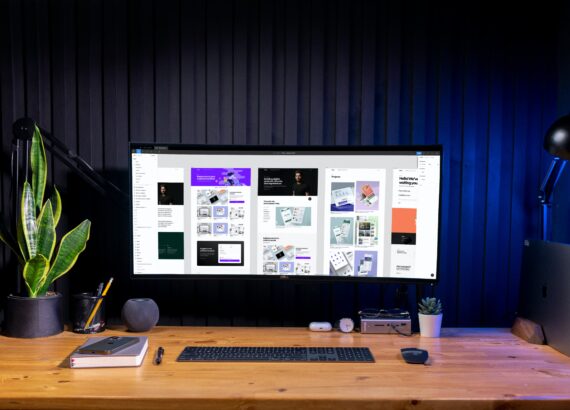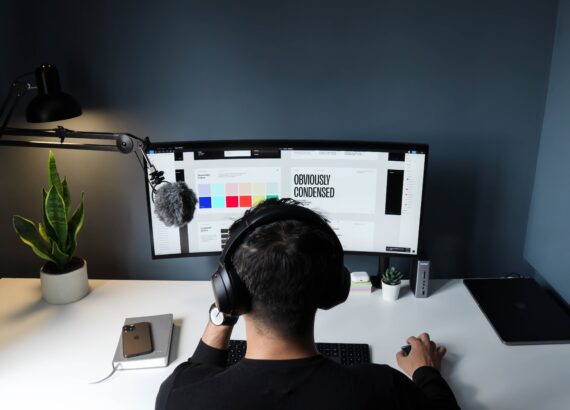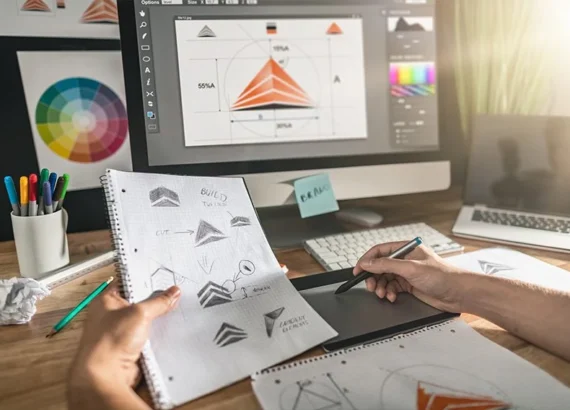Start Career as Freelance Graphic Designer
Freelance graphic design offers an exciting and flexible career path for creative individuals who possess a passion for visual communication. Embracing the freelance lifestyle allows graphic designers to showcase their talent, work on diverse projects, and have control over their professional growth. However, starting a career as a freelance graphic designer requires careful planning, honing of skills, and the ability to navigate the competitive design industry. In this article, we will explore the essential steps and strategies to embark on a successful journey as a freelance graphic designer, from building a strong skillset and portfolio, to finding clients, managing projects, and growing your career.
1. Introduction to Freelance Graphic Designing
Understanding the Basics of Freelance Graphic Design
Freelance graphic designing is an exciting and flexible career path that allows you to channel your creativity into creating visually stunning designs for a wide range of clients. As a freelance graphic designer, you have the freedom to choose your projects, work from anywhere, and be your own boss. But before diving into this world, it’s important to understand the basics.
In freelance graphic design, you’ll be responsible for creating various visual assets such as logos, brochures, website designs, and more. You’ll need a solid understanding of design principles, software proficiency, and a knack for staying up-to-date with industry trends. Ready to embark on this creative journey? Let’s dive in!

2. Building the Necessary Skills and Portfolio
Creating an Impressive Graphic Design Portfolio
To succeed as a freelance graphic designer, it’s essential to build a strong foundation of skills and create an impressive portfolio that showcases your work. Start by developing proficiency in graphic design software such as Adobe Photoshop, Illustrator, and InDesign. Familiarize yourself with their features and functionalities to unleash your creativity.
Additionally, mastering design principles and techniques is crucial. Understand color theory, typography, layout, and composition to create visually appealing designs that communicate effectively.
Lastly, create an impressive graphic design portfolio that highlights your best work. Include a variety of projects that showcase your range of skills and creativity. Remember, your portfolio is your calling card, so make it stand out!
3. Establishing a Professional Identity and Brand
Building an Engaging Graphic Design Website
As a freelance graphic designer, it’s important to establish a professional identity and brand that sets you apart from the competition. Start by defining your unique graphic design style. Whether it’s minimalist, bold, or whimsical, let your style shine through in your work to attract clients who resonate with your aesthetic.
Next, create a professional graphic designer logo that reflects your brand identity. Your logo should be memorable, visually appealing, and representative of your design style. Consider hiring a graphic designer or using online tools to create a logo that stands out.
In addition to a logo, it’s essential to build an engaging graphic design website. Your website should showcase your portfolio, provide information about your services, and make it easy for potential clients to contact you. Personalize your website with your unique personality and style to make a lasting impression.
4. Setting Up and Managing Your Freelance Business
Setting Up Accounting and Bookkeeping Systems
Running a successful freelance graphic design business requires proper organization and management. Start by choosing a business structure that suits your needs, whether it’s as a sole proprietor, LLC, or corporation. Consider consulting with a legal professional or accountant to understand the legal and financial implications of each structure.
Once you’ve decided on a business structure, register your freelance business and obtain any necessary licenses or permits. Doing so will ensure that you operate legally and protect yourself from potential liabilities.
Finally, set up accounting and bookkeeping systems to track your income and expenses. Consider using accounting software or hiring an accountant to keep your finances in order. It’s crucial to stay on top of your financials to maintain a healthy and profitable freelance business.
Remember, embarking on a freelance graphic design career is an exciting adventure filled with endless possibilities. By building your skills, establishing a professional identity, and managing your business effectively, you’ll be well on your way to success in this creative and rewarding field. So let your creativity soar, and get ready to make your mark as a freelance graphic designer!
5. Finding and Securing Clients as a Graphic Designer
Build Network and Relationship
Whoever said it’s not about what you know, but who you know, might have been onto something. As a freelance graphic designer, networking and building relationships in the design industry can open doors to exciting opportunities. Attend design conferences, join online communities, and connect with other professionals in your field. Remember, networking is not just about small talk and exchanging business cards; it’s about building genuine relationships that can lead to client referrals and collaborations. So, put on your best “designer” shoes and get out there!
Utilizing Online Platforms and Freelance Job Boards
In the digital age, online platforms and freelance job boards can be your secret weapon for finding clients. Websites like Upwork, Fiverr, and Dribbble allow you to showcase your portfolio and bid on projects that match your skills. Be sure to create a compelling profile, highlight your expertise, and regularly update your portfolio to stand out from the crowd. Remember, persistence is key when it comes to securing clients online. Keep submitting proposals, refining your pitch, and eventually, the gigs will start rolling in!
Effective Strategies for Pitching and Winning Graphic Design Projects
Pitching your services as a graphic designer can be nerve-wracking, but with the right strategies, you can increase your chances of winning projects. Start by thoroughly understanding the client’s needs and objectives. Tailor your pitch to address their specific challenges and demonstrate how your design skills can provide solutions. Use visual aids and case studies to showcase your previous work and make your pitch memorable. And don’t forget to sprinkle a touch of your personality and wit throughout your proposal – clients appreciate a designer who can bring some fun to the table!
6. Pricing and Negotiating Contracts as a Freelancer
Determining Your Graphic Design Rates and Pricing Structure
The age-old question: how much should you charge as a freelance graphic designer? While there’s no one-size-fits-all answer, take into account factors like your experience, skill level, and the market rates in your area. Consider whether you want to charge by the hour, project, or retainership. Don’t undersell your talent, but also be mindful of not overpricing yourself out of the market. Experiment with different pricing structures and adjust as you gain more experience and confidence in your abilities.
Understanding Contract Terms and Negotiating Skills
Contracts might seem intimidating, but they are your best friend as a freelancer. Take the time to understand contract terms and ensure they protect both you and your client. Clearly define project scope, deadlines, deliverables, payment terms, and ownership rights. Be prepared to negotiate, but also know your boundaries. Don’t be afraid to walk away from a project if the terms don’t align with your values or if the client is not willing to meet your reasonable demands. Remember, you’re a talented graphic designer, and there will always be new opportunities knocking at your door!
Protecting Yourself with Clear Project Scope and Terms of Service
Scope creep – the silent enemy of freelancers everywhere. Avoid headaches and potential disputes by clearly defining the project scope from the get-go. Outline what is included and excluded in your services, along with the number of revisions allowed. Communicate your terms of service, such as late payment penalties or additional charges for rush projects. Having these boundaries set in stone protects both you and the client, ensuring a smooth and successful working relationship.
7. Managing Workload and Meeting Deadlines as a Freelancer
Creating an Efficient Schedule and Workflow
Ah, the art of juggling multiple projects and meeting those dreaded deadlines. Set aside specific hours for different tasks, allowing for breaks and relaxation too – you’re not a design robot! Utilize tools like project management software or a good old-fashioned to-do list to keep track of your tasks and deadlines. Remember, organization is key to maintaining your sanity and delivering exceptional work.
Effective Time Management Techniques for Freelance Graphic Designers
Time management can be a designer’s superpower. Prioritize your tasks based on deadlines and urgency. Break down big projects into smaller, manageable chunks to avoid feeling overwhelmed. Avoid multitasking – it’s a creativity killer! Instead, focus on one project at a time and give it your undivided attention. If you find yourself getting distracted, try the pomodoro technique – work in short, focused bursts with intermittent breaks. And remember, it’s okay to say no to new projects if your plate is already overflowing – quality over quantity!
Dealing with Client Revisions and Managing Scope Creep
“Can you make the logo bigger?” – a freelancer’s worst nightmare. Client revisions are a part of the job, but managing them efficiently is a skill worth mastering. Clearly communicate upfront how many revisions are included in your services, and charge extra for additional changes. Encourage clients to provide detailed feedback to avoid endless back-and-forth. If a revision goes beyond the agreed-upon scope, gently remind the client of the project boundaries and propose a separate agreement for the additional work. Remember, you’re the designer, and your expertise should guide the revision process.
8. Growing and Marketing Your Freelance Graphic Design Career
Expanding Your Skill Set and Staying Updated with Industry Trends
As a freelance graphic designer, continuous learning and growth are essential. Stay updated with industry trends and incorporate new techniques and software into your skill set. Take online courses, attend workshops, or experiment with personal projects to expand your design repertoire. The design world is constantly evolving, and being adaptable and open to learning will make you a sought-after designer.
Utilizing Social Media and Online Marketing Strategies
Harness the power of social media to showcase your work and attract clients. Create a strong online presence by curating a professional portfolio website and utilizing platforms like Instagram, Behance, or Dribbble to share your designs. Engage with the design community, collaborate with other creatives, and leverage social media algorithms to amplify your reach. Don’t be afraid to show your personality and share behind-the-scenes glimpses of your creative process. Remember, clients not only want a talented designer, but someone they can connect with on a personal level.
Building a Strong Reputation Through Client Testimonials and Reviews
Word-of-mouth is a freelancer’s best friend. Encourage happy clients to provide testimonials and reviews of your work. These endorsements build trust and credibility, attracting potential clients. Showcase these testimonials on your website and social media platforms to let your reputation speak for itself. Go the extra mile for your clients, deliver exceptional work, and provide a positive experience – the power of a good reputation cannot be overstated.
Now that you have the tools to kickstart your freelance graphic design career, go forth, create amazing designs, and let your unique personality shine. The freelance world awaits, and you’re ready to conquer it with your wit, talent,
Conclusion
Embarking on a career as a freelance graphic designer can be a rewarding and fulfilling choice for those with a passion for creativity and design. By following the steps outlined in this article, you can set yourself up for success in the competitive world of freelance graphic design. Remember to continually improve your skills, build a strong portfolio, and establish a professional brand to attract clients. With dedication, perseverance, and a commitment to delivering high-quality work, you can create a thriving freelance graphic design career that offers both artistic fulfillment and financial stability.
FAQ
1. How do I determine the right pricing for my freelance graphic design services?
Setting the right pricing for your freelance graphic design services can be a challenge. Factors to consider include your level of experience, the complexity of the project, the time and effort required, and the market rates in your area. Conducting market research, analyzing competitors’ pricing, and considering the value you provide to clients can help you determine a fair and competitive rate.
2. How can I find clients as a freelance graphic designer?
There are various ways to find clients as a freelance graphic designer. Networking within the design industry, attending events, and joining professional organizations can help you connect with potential clients. Utilizing online platforms and freelance job boards, creating a compelling portfolio website, and leveraging social media to showcase your work are effective strategies for attracting clients. Additionally, leveraging referrals and word-of-mouth recommendations can help you expand your client base.
3. What should I include in my graphic design portfolio?
Include a variety of projects that demonstrate your versatility and skills in different design styles and mediums. Organize your portfolio in a visually appealing and easy-to-navigate manner, providing a brief description or context for each project. It’s also beneficial to include client testimonials or feedback to build trust and credibility with potential clients.
4. How do I manage my workload and meet deadlines as a freelance graphic designer?
Managing your workload and meeting deadlines is crucial for maintaining a successful freelance graphic design career. Implementing effective time management techniques, such as creating a schedule, setting priorities, and breaking projects into smaller tasks, can help you stay organized and on track. Communicating clearly with clients about project timelines and expectations from the start is also essential. Additionally, learning to manage revisions and scope creep can help you maintain a healthy work-life balance and ensure timely project delivery.
Thank you for reading 🙂














